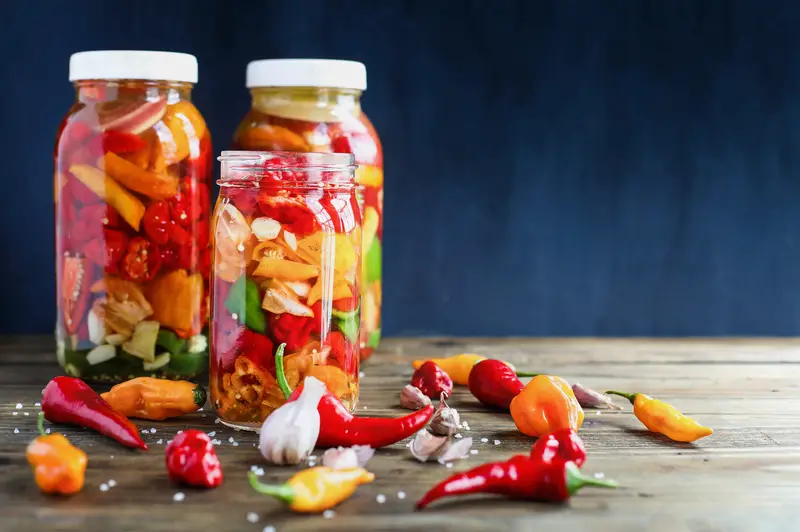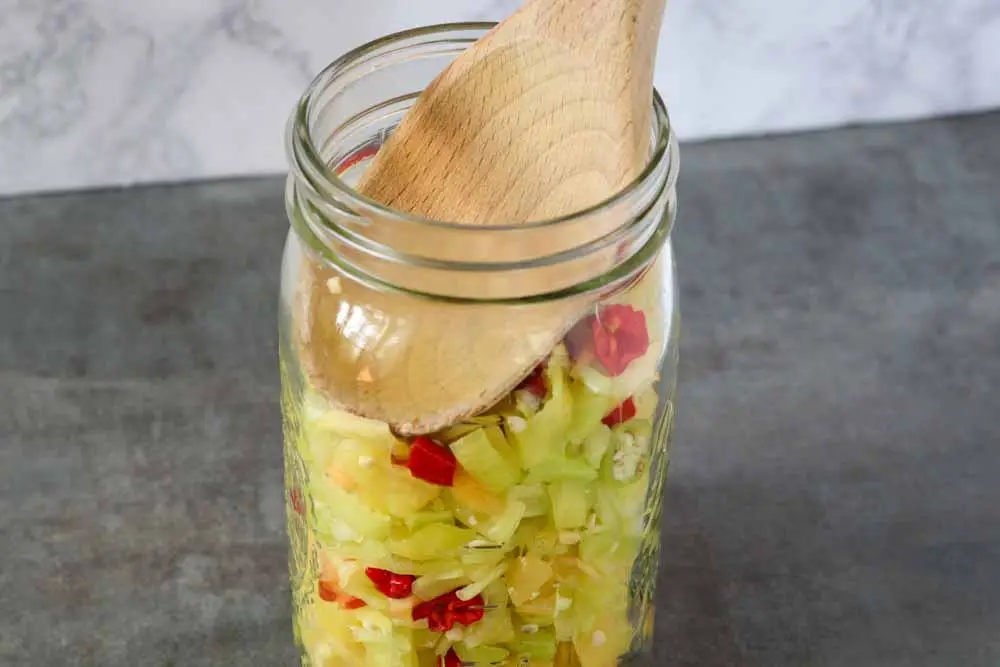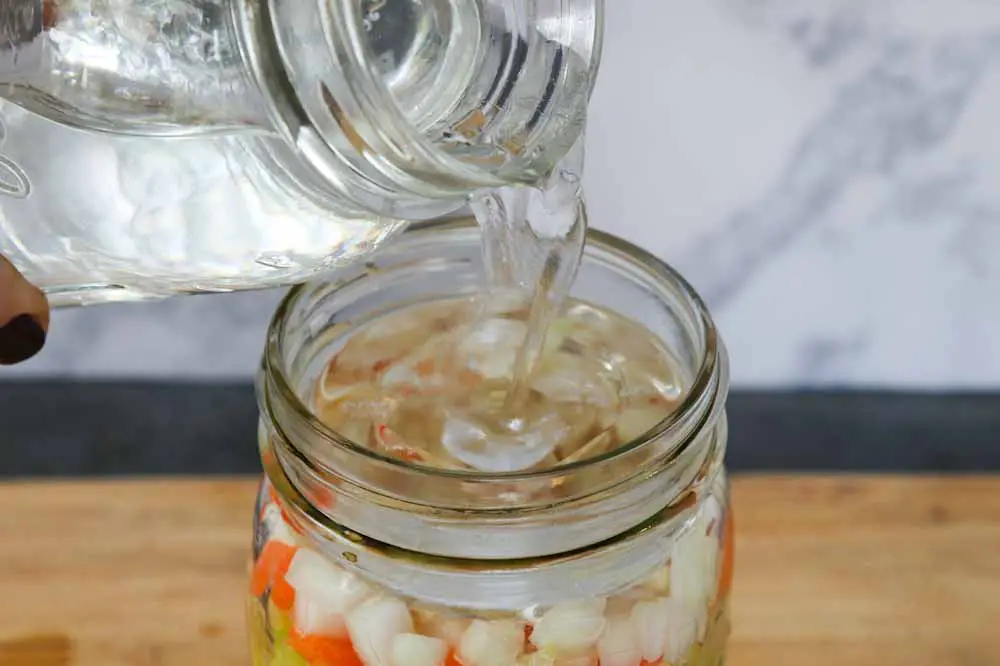
We may receive commissions from purchases made through links in this post, at no additional cost to you.
Fermented hot sauce is new territory for me, but I’m never going back. What better recipe is there than one that involves letting the ingredients sit out on the counter for a week or so, then blending them up in the blender? That’s pretty much it. Oh, and it goes with everything.
This recipe is the perfect use for a bumper crop of peppers from the garden. Peppers are one of my favorite things to grow because they are perfect for my hot climate. And, living in Texas you soon learn that just about everything is better with some hot sauce or salsa on it.
Picking the Right Peppers
This is a versatile recipe, so you can basically use whatever peppers you can find. I wanted to keep a bright yellow-orange color, so I chose to use Sugar Rush Peach peppers. This pepper variety is truly both sweet (like a red bell pepper) and a little hot (similar to a jalapeno).

I grew my peppers from seed, and they were a breeze to grow. I bought the seeds from Baker Creek Heirloom Seeds (rareseeds.com – I am not an affiliate!). They have tons of interesting, unusual pepper varieties to choose from.
If you can’t find (or grow) Sugar Rush Peach peppers, use any yellow or orange peppers you can find. A combination of mild and hot peppers, such as banana peppers, habaneros, or even bell peppers, will allow you to control the level of heat in the finished sauce. I used a few red Shishito peppers (also from my garden) to heighten the orange color.
Why ferment hot sauce?
If fermentation is new to you, don’t be intimidated. Fermentation is simply the process of carbohydrates in food being broken down by good bacteria – in this case, lactic acid bacteria. The sugars and starches in the peppers are converted into lactic acid, which gives fermented foods their pleasant tangy flavor.

This pre-breaking-down of the carbohydrates means that the food is easier to digest, and that more nutrients are readily available to be absorbed by the gut. In other words, fermented foods are healthier for you.
When done properly (that is, when air is kept out of the fermentation vessel) the fermentation process keeps bad bacteria away and allows good bacteria to flourish. Fermentation is an ancient preserving method that improves the flavor, shelf life, and nutrition of foods.
Do you need special equipment to ferment?
No special equipment is needed to ferment hot sauce. As long as you have a large, lidded jar to ferment in, and a smaller jar or weight (I use these inexpensive fermentation weights) to keep the food submerged in the brine, you’re good to go.
Recipe Instructions:
I adapted my recipe from this one from Practical Self Reliance.
First, prepare the vegetables. Remove the seeds and stems from the peppers, then chop them into pieces about ½ inch long. Also chop the carrots, onion, and garlic.

Make the brine by mixing the salt and water until the salt is dissolved. Stuff all of the vegetables in a large jar, pressing down to remove as much air as possible.

Place the smaller jar or weight on top of the vegetables, then pour the brine over the top. The veggies should be completely covered by brine. This is a really important step – air is the enemy of good fermentation. All of the vegetables should stay submerged throughout the fermentation process.

Place the lid on the jar and partially tighten. Make sure that it is covered, but slightly loose so that air can escape as the peppers ferment and release gas. Leave the jar in a cool dark place to ferment (I put mine in the pantry).

After 7 days, taste the peppers. Don’t worry if your brine now looks a little whitish, or milky (like mine, above) – this is a normal part of fermentation. If you are pleased with the flavor, then proceed to the next step. Otherwise, re-cover the jar and leave to ferment a few more days, up to about 10 days or so.
When you are ready to make the sauce, strain the peppers, but reserve the brine. Blend the fermented peppers with the vinegar, honey, ½ of reserved brine, and about 1 ½ cups of mango puree until smooth.

Taste the sauce and adjust to your liking. If it needs to be saltier, add more brine. For more acidity, vinegar, and more sweetness, honey and/or mango.
Finally, if you want a smooth sauce, strain it through a sieve to remove any larger pieces of vegetables that may still be present. Bottle, and enjoy! This Fermented Sugar Rush Peach Pepper and Mango Hot Sauce will keep for a long time in the refrigerator, up to 6 months (possibly longer). But I doubt it will last that long…


Fermented Sugar Rush Peach Pepper and Mango Hot Sauce
Equipment
- Quart mason jar and lid
- Small jar or fermentation weight
- Blender
Ingredients
- 2 cups water
- 1.5 tablespoons sea salt
- 1 lb. yellow or orange peppers I used Sugar Rush Peach and some red Shishitos, but use a mix of banana peppers, habaneros, or other yellowish peppers
- 6 garlic cloves
- 1/2 yellow or white onion
- 1 medium carrot or 5-6 baby carrots
- 2 tablespoons apple cider vinegar
- 1 tablespoon honey
- 2 mangos
Instructions
- Prepare the vegetables. Cut the peppers in half lengthwise and remove the seeds and stems. Chop into 1/2-inch pieces. Also chop the carrot and onion into ½-inch pieces. Peel and roughly chop the garlic cloves.
- Make the brine. Mix the salt into the water and stir until dissolved. If you need more brine, mix more water and salt at the same proportions.
- Fill the jar. Layer the chopped peppers, carrots, onion, and garlic in the jar. Use a wooden spoon to press down on the vegetables, removing as much air as possible. Place the small jar or fermentation weight on top.
- Pour the brine on top of the vegetables, leaving about an inch of head space. All of the vegetables should be completely submerged in the liquid.
- Ferment. Place the lid on the jar and partially tighten (not too tight – you want air to be able to escape). Leave the jar in a cool, dark place to ferment. After 7 days, check the peppers. If you are happy with the flavor and level of tang, proceed to the next step. Otherwise continue to let it ferment for up to 10 days total.
- Prepare mango puree. When you are ready to make the final sauce, peel and roughly chop 2 mangoes and place into a blender. Blend into a smooth puree; set aside.
- Blend. Drain the fermented chopped vegetables through a sieve but reserve the liquid. Place the veggies into a blender with 2 tablespoons of apple cider vinegar, 1 tablespoon honey, 1/2 cup of the reserved brine, and 1 ½ cups of mango puree. Blend until very smooth, taste and adjust seasoning to your liking (add more mango, honey, brine, or vinegar as desired). If you want a smoother sauce, strain the finished sauce to remove any remaining large solids (see Notes below).
- Transfer the hot sauce into jars or bottles and refrigerate. Use within 6 months.

